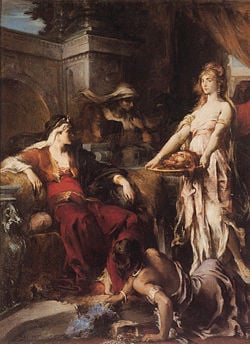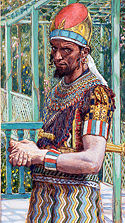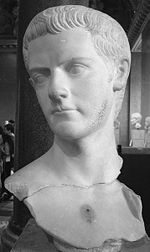Herod Antipas
| Herod Antipas | ||
|---|---|---|
| Tetrarch of Galilee and Perea | ||

| ||
| Antipas (left) views John the Baptist's head | ||
| Reign | 4 B.C.E. – AD 39 | |
| Born | Before 20 B.C.E. | |
| Died | After AD 39 | |
| Gaul | ||
| Predecessor | Herod the Great | |
| Successor | Agrippa I | |
| Father | Herod the Great | |
| Mother | Malthace | |
Herod Antipas (before 20 B.C.E. – after 39 C.E.) was a first-century CE Jewish-Idumean ruler of Galilee and Perea, who bore the title of tetrarch ("ruler of a quarter"). He governed these territories for more than 40 years, but is best known from New Testament accounts describing his role in the events that led to the executions of John the Baptist and Jesus of Nazareth.
The son of Herod the Great, Antipas ruled as a client king of the Roman Empire over a much smaller area than his father had. He was responsible for building projects at Sepphoris and Betharamphtha and the construction of his capital, Tiberias, on the western shore of the Sea of Galilee. Antipas provoked controversy when he divorced his first wife, the daughter of King Aretas IV of Nabatea, in favor of Herodias, who had formerly been married to his brother, Herod II. John the Baptist's condemnation of this arrangement led Antipas to have him arrested and subsequently executed in dramatic fashion, as told in the Gospels. The Gospel of Luke relates that when Jesus was brought before Pontius Pilate for trial, Pilate handed him over to Antipas, in whose territory Jesus had been active. However, Antipas sent him back to Pilate.
Antipas' divorce added a personal grievance to an ongoing dispute with Aretas over territory on the border of Perea and Nabatea, leading to war that dealt Antipas a serious setback. In 39 C.E. he was accused by his nephew, Agrippa I, of conspiracy against the new Roman emperor, Caligula, who sent him into exile in Gaul. Accompanied there by Herodias, he died at an unknown later date.
Biography
Early life
Antipas was the son of King Herod the Great of Judea by one of Herod's several wives, Malthace, who was from Samaria.[1] His date of birth is uncertain. Named for his grandfather Antipater, he was educated in Rome, along with his full brother Archelaus and his half-brother Philip, both of whom also bore the surname of Herod.
Antipas was not Herod the Great's first choice for heir. That honor originally fell to Aristobulus and Alexander, Herod's sons by the Hasmonean princess Mariamne. However, these heirs fell afoul of Herod's suspicious and ruthless nature and were consequently executed for treason (c. 7 B.C.E.), as was their mother. Herod's oldest son, Antipater, was then convicted of attempting to poison his father (5 B.C.E.), and the new heir-apparent, Herod II, also fell out of favor. The now-elderly Herod fell back on his youngest son, Antipas, revising his will to make him heir. During his fatal illness in 4 B.C.E., Herod had yet another change of heart about the succession. According to the final version of the will, Antipas' elder brother Archelaus was to become king of Judea, Idumea, and Samaria, while Antipas would rule Galilee and Perea. Philip was to receive Gaulanitis (the Golan Heights), Batanaea (southern Syria), Trachonitis, and Auranitis (Hauran).
Because of Judea's status as a Roman client kingdom, Herod's plans for the succession had to be ratified by Augustus. The three heirs therefore traveled to Rome to make their claims, Antipas arguing he ought to inherit the whole kingdom and the others maintaining that Herod's final will ought to be honored. Augustus largely confirmed the division of territory set out by Herod in his final will, with Archelaus taking the prize territories. The brothers, however, had to be content with the title of ethnarch rather than king.
Early reign

██ Territory under Herod Archelaus██ Territory under Herod Antipas██ Territory under Herod Philip II██ Cities of Jabneh, Azotas, Phaesalis██ Roman province of Syria██ Autonomous cities: The Decapolis
After matters were resolved in Rome, Antipas began his reign about a year before the turn of the Common Era and enjoyed the confidence of Rome for four decades. Archelaus, however, was soon deemed incompetent by Augustus and replaced with a prefect in 6 C.E.
Antipas' territories were separated by the region of the Decapolis, with Galilee to the north and Perea to the south. It was in the Galilee that Jesus of Nazareth's family settled after returning from Egypt, according to Matthew's account, because Joseph felt unsafe under Archelaus in Judea (Matthew 2:22).
Antipas faced several challenges to his rule early in his reign. While he had been making his case to Augustus in Rome, a Jewish faction led by Judas, son of Hezekiah, had attacked the palace of Sepphoris in Galilee, seizing money and weapons. This Judas may be identical with the Judas of Galilee who led resistance to the census conducted by the Roman governor of Syria, Quirinius, and who is mentioned by the Pharisaic leader Gamaliel in Acts 5:37 as a would-be Messiah. In a counterattack ordered by the Roman general Quinctilius Varus, Sepphoris was destroyed by fire and many of its inhabitants sold as slaves. Perea, meanwhile, bordered on the kingdom of Nabatea, which had long experienced uneasy relations with both the Romans and the Jews.
Antipas, like his father before him, demonstrated his value both to the Romans and to many Jews by various impressive construction projects. He rebuilt and fortified Sepphoris, and current scholarship suggests that the "carpenter" Joseph and his sons may have found work in there, Sepphoris being was about five miles distance from Nazareth. Antipas also added a wall to Betharamphtha in Perea, renaming it "Livias" after Augustus' wife Livia, and later "Julias" after the emperor's daughter.
However, his most famous construction project was his capital on the western shore of the Sea of Galilee—Tiberias, named to honor his patron, Emperor Tiberius, who had succeeded Augustus in 14 C.E. Residents there could bathe nearby at the warm springs of Emmaus, and by the time of the First Jewish-Roman War the city's buildings included a stadium, a royal palace, and a sanctuary for prayer. It later became a center of rabbinic learning.
For many Jews and others living in his lands, Antipas was a successful ruler who provided jobs and security. The otherwise unknown party or sect mentioned in the New Testament as the Herodians may have been ardent supporters of Antipas, perhaps hoping that he would come to rule over a united Jewish kingdom including Judea and Samaria rather than serving as tetrarch of only the northern and eastern territories. However, pious Jews at first refused to live in Tiberias because it was built atop a graveyard and was therefore a source of ritual impurity. Antipas thus had to colonize Tiberas with a mixture of foreigners, forced migrants, freed slaves, and impoverished Jews. Some had no desire to support Antipas, whom they viewed as a Roman collaborator, and the party known as the Zealots actively opposed Roman rule.
Despite his eagerness to please Rome, Antipas at times showed particular sensitivity to Jewish tradition. His coins carried no images of persons or animals, which would have violated Jewish prescriptions against idolatry. And when Pontius Pilate, governor of Judea from 26 C.E. to 36 C.E., caused offense by placing Roman votive shields in the royal palace at Jerusalem, Antipas and his brothers successfully petitioned for their removal.[2]
John the Baptist and Jesus



Early in his reign, Antipas had married the daughter of King Aretas IV of Nabatea (Southern Syria). However, while staying in Rome with his half-brother, Herod II, he fell in love with his host's wife, Herodias, who, unlike Antipas, carried noble Hasmonean blood. Antipas and Herodias agreed to divorce their previous spouses in order to marry each other, a move which, besides its romantic motive, would also increase any future claim to the Judean throne by Antipas, who was a Samaritan on this mother's side.[3]
The divorce naturally soured Antipas' relations with Aretas. It also provoked controversy closer to home. Probably around 28-29 C.E., John the Baptist began preaching and baptizing pilgrims by the Jordan River, which marked the western edge of Antipas' territory of Perea. Mark 6:20 indicates that Antipas was impressed with John's preaching. However, John attacked Antipas' marriage as contrary to Jewish law, and the Jewish historian Josephus confirms that John's public influence made Antipas fearful of rebellion.[4] Consequently, John was imprisoned, probably in Machaerus, and later executed. According to Matthew and Mark, Herod was reluctant to order John's death but was compelled to deliver the Baptist's head to Herodias' daughter (unnamed here but called Salome by Josephus), to whom he had promised any reward she chose in exchange for her dancing for him.[5]
Among those baptized by John was Jesus of Nazareth, who began his own ministry in Galilee around the time of John's imprisonment. So similar were John's and Jesus' ministries that Antipas feared that the Baptist had been raised from the dead.[6] Luke reports that a group of Pharisees warned Jesus that Antipas was plotting his death, whereupon Jesus denounced the tetrarch as a "fox."[7]
Luke, unlike the other Gospels, also credits Antipas with a role in Jesus' trial. In this version, Pilate, on learning that Jesus was a Galilean, sent him to Antipas, who was in Jerusalem at the time. Initially, Antipas was pleased to see Jesus, hoping to see him perform a miracle, but when Jesus remained silent in the face of his questioning, Antipas mocked him and sent him back to Pilate. Luke reports that these events improved relations between Pilate and Herod despite some earlier enmity.[8]
Antipas' involvement in the trial of Jesus has been much debated. Some hold that there is a basis for the idea that, in the early Roman Empire, defendants were to be tried by the authorities of their home provinces, while others conclude that trials were generally based on the location of the alleged crimes. Some scholars take the view that Jesus' trial by Herod Antipas is simply unhistorical. The fact that Matthew and Mark, as well as John, know nothing of Antipas' role is one argument in favor of this opinion. It has also been suggested that the trial by Antipas is a literary composition by Luke designed to parallel the trials of Paul, which Luke reports in his Book of Acts.
Later reign
Meanwhile, border disputes between Antipas and King Aretas of Nabatea had been slowly moving toward open warfare, exacerbated by Antipas' divorce of Aretas' daughter. In 36 C.E. Antipas' army suffered a serious defeat after fugitives from the former tetrarchy of Philip sided with the Nabateans. Antipas was forced to appeal to Tiberius for help. The emperor ordered Lucius Vitellius, the Roman governor of Syria, to march against Aretas and ensure that he was captured or killed. Vitellius mobilized two legions, sending them on a detour around Judea and meanwhile joining Antipas in attending a festival at Jerusalem. While there, he learned of the death of Tiberius on March 16, 37. He then recalled his troops.[9]
The new emperor, Caligula, proved to be no friend to Antipas. When Herodias' brother, Agrippa I, had fallen into debt during the reign of Tiberius, Herodias had persuaded Antipas to provide for him. However, the two men quarreled, and Agrippa soon departed. Agrippa was friendly with Caligula while Tiberius was still emperor but ended up in prison for speaking against Tiberius. When Caligula acceded to the throne in 37 C.E., he not only released his friend but granted him rule of Philip's former tetrarchy, expanding its territory and giving him the title of king. Josephus relates that Herodias, jealous at Agrippa's success, persuaded Antipas to ask Caligula for the title of king as well. However, Agrippa simultaneously presented the emperor with a list of charges against Antipas, including that he plotted against the emperor and that Antipas had a stockpile of weaponry sufficient for 70,000 men. Antipas' admitted having the weapons but insisted on his loyalty; Caligula decided that the tetrarch constituted a threat.
In the summer of 39 C.E., Antipas' territory, wealth, and possessions were turned over to Agrippa, and Antipas was sent into exile. The place of his exile is given by Josephus as "Lugdunum" in Gaul.[10] This may mean the city now known as Lyon, or the less important Lugdunum Convenarum, which is modern Saint-Bertrand-de-Comminges. Caligula offered to allow Herodias, as Agrippa's sister, to retain her property if she separated from Antipas. However, she chose instead to join her husband in exile, where they died at an unknown date. The third-century historian Cassius Dio implies that Caligula had him killed, but this is usually treated with skepticism by modern historians.
Legacy
Antipas became famous in Christian tradition for his role in the death of John the Baptist and the trial of Jesus. A good deal of confusion exists among readers of the New Testament concerning his identity, however, as the Gospels do not give his name as Antipas, but rather as simply "Herod" or "Herod the tetrarch."
Among the followers of Jesus and members of the early Christian movement mentioned in the New Testament are Joanna, the wife of one of Antipas' stewards, and Manaen, a "foster-brother" or "companion" of Antipas who later became a teacher in the church at Antioch.
The pseudepigraphical Gospel of Peter claimed that it was Antipas rather than Pilate who ordered the crucifixion of Jesus. In line with the work's anti-Jewish theme, this work pointedly remarked that Antipas and "the Jews," unlike Pilate, refused to "wash their hands" of responsibility for the death.
In modern times, the Reverend Sun Myung Moon taught that John the Baptist's criticism of Antipas was a fatal error and that it was John's duty to mediate between Jesus and Jewish rulers like Antipas. Antipas has also appeared in a large number of more film representations of the passion of Jesus. Early Hollywood portrayals depicted him as exceedingly lustful in his desire for Herodias' daughter, while the more recent films Jesus Christ Superstar and The Passion of the Christ, portray him as effeminate. He also features in The Secret Magdalene by Ki Longfellow, where he is depicted as rash, ineffective, and willing to do anything to save himself.
| House of Herod Died: after AD 39 | ||
|---|---|---|
| Preceded by: Herod I |
Tetrarch of Galilee 4 B.C.E. – AD 39 |
Succeeded by: Agrippa I |
Notes
- ↑ Josephus, Antiquities 17.20, War. Retrieved January 25, 2009.
- ↑ Philo, On the Embassy to Gaius 299–305. Retrieved February 21, 2009.
- ↑ Mark 6:17 calls Herodias' former husband Philip; either the author is confusing him with Philip the tetrarch, or both Philip and Herod II shared the name Philip.
- ↑ Matthew 14:3-4; Mark 6:17-18; Luke 3:19; Josephus, Antiquities 18.118. Retrieved January 25, 2009.
- ↑ Matthew 14:6-11; Mark 6:19-28.
- ↑ Matthew 14:1-2; Mark 6:14-16; cf. Luke 9:7-9.
- ↑ Luke 13:31-33.
- ↑ Luke 23:5-12.
- ↑ Josephus, Antiquities 18.120–126. Retrieved January 25, 2009.
- ↑ Josephus, Antiquities 18.252 Retrieved January 25, 2009.
ReferencesISBN links support NWE through referral fees
- Darr, John A. Herod the Fox: Audience Criticism and Lukan Characterization, Journal for the study of the New Testament, 163. Sheffield: Sheffield Academic Press, 1998. ISBN 9781850758839
- Hoehner, Harold W. Herod Antipas, Cambridge [Eng.]: University Press, 1972. ISBN 9780521081320
- Kokkinos, Nikos. The Herodian Dynasty: Origins, Role in Society and Eclipse, Journal for the study of the pseudepigrapha, 30. Sheffield, England: Sheffield Academic Press, 1998. ISBN 9781850756903
- Jensen, Morten Hørning. Herod Antipas in Galilee: The Literary and Archaeological Sources on the Reign of Herod Antipas and Its Socio-Economic Impact on Galilee, Wissenschaftliche Untersuchungen zum Neuen Testament, 215. Tübingen: Mohr Siebeck, 2006. ISBN 9783161489679
External links
All links retrieved July 16, 2024.
- Galilee under Antipas
- Antipas – entries in historical sourcebook by Mahlon H. Smith.
Credits
New World Encyclopedia writers and editors rewrote and completed the Wikipedia article in accordance with New World Encyclopedia standards. This article abides by terms of the Creative Commons CC-by-sa 3.0 License (CC-by-sa), which may be used and disseminated with proper attribution. Credit is due under the terms of this license that can reference both the New World Encyclopedia contributors and the selfless volunteer contributors of the Wikimedia Foundation. To cite this article click here for a list of acceptable citing formats.The history of earlier contributions by wikipedians is accessible to researchers here:
The history of this article since it was imported to New World Encyclopedia:
Note: Some restrictions may apply to use of individual images which are separately licensed.

